By Drs. Bruce Hobson (biography and disclosures), Daniel Ngui (biography and disclosures), Christie Newton (biography and disclosures), Shirley Sze (biography and disclosures) and Steve Wong (biography and disclosures)
Disclaimer: Suggestions offered in this article are not evidence-based or even what is necessarily the best option out there. These suggestions are anecdotal, based on our own experience, and shared with our readers in the hope that they will help you during this difficult time of change. Please add your tips and resources in the comments below. Feedback would be appreciated so that this information can be updated and re-shared.
What I have noticed
The COVID-19 pandemic is requiring us to change the way we practice medicine, now and into the future. When I first ‘met’ the internet and signed onto bulletin boards, file sharing with my 1200 baud modem over the telephone line, I thought that this was something that would never catch on. It was slow and unreliable. There was nothing worse than having a file download interrupted by someone picking up the phone!
Years later, with significant technological improvements, I was emailing patients, sharing useful information, and receiving pictures of ‘Healthy Plates’, digital scale readings, and records of activities. Finally, when telehealth and then virtual care billings came available, I tried various ways of connecting with my patients. I tried several virtual platforms and even used my cell phone with caller ID blocked.
What I discovered was that there is no one ‘perfect’ solution. Different means of communication work for different patients. What I found important was to ask my patients three questions:
- Would you like to follow-up with me on that?
- When would you like to follow-up?
- What is the best way for you to follow-up with me?
The key is working with the patient using a solution that works best for them.
Virtual care is a different way of providing care and even though it is not how I was trained, I have found that virtual encounters do work. Virtual care is not necessarily second-best to face-to-face encounters, and where appropriate, it can be better.
What I recommend (practice tips)
Here is what I have learned along the way of adopting virtual care:
We must adopt a different approach to virtual care and acknowledge that both clinicians and patients are new to this. It is a learning experience for both. The transition to offering telemedicine can be successful if you know the resources available to you and use them to take a systematic approach engaging your team and patients.
- Be prepared for the unexpected. Anticipate that technology may fail and ensure you have a backup.
- If possible, have a backup virtual platform ready to go if one platform fails for you or your patient.
- Have the patient’s phone number at hand and ready to go if the platform fails.
- Sometimes, you might not have the necessary bandwidth to support audio and video on your virtual platform:
- If the video is not working well, switch to audio only.
- Use the phone for audio and virtual platform for video.
- You can use your smartphone’s hotspot feature to connect to the internet via your provider network. This can be a good option even for video chat, however watch your data usage!
- Use a hardwired internet connection where possible, the connection speed will be better than a wireless connection.
- Consider having two monitors or a tablet with the virtual platform downloaded onto it. You could use your computer for EMR access and data entry and the tablet or second monitor for the virtual platform video.
- You can have a virtual waiting room.
- Your MOA can run a virtual waiting room of their own. They can deal with technical issues, dispense information, triage patients, even host a waiting room chat, and finally they can send the patient to your virtual office when you’re ready.
- You can set virtual backgrounds on some platforms, kind of like TV weather person’s backdrop.
- Virtual visits could be longer than in-person visits, particularly as you and your patients become familiar with the new technology.
- Test out the technology with friends, family or colleagues if possible. Going through the process in a low-stakes setting will help you become more comfortable.
- Try to arrange support for your patients who may struggle with technology, including your elderly patients.
- Be prepared to troubleshoot tech issues with your patients, but don’t spend too long trying to fix connections problems. Switch to a simpler solution, like the phone, if there are difficulties.
- Prepare an agenda for the virtual meeting. EMR templates with built in Clinical Decision support can help guide the conversation and provide access through links for the patient and/or provider resources.
- Be proactive in your care.
- Anticipate which patients are vulnerable or at risk and reach out to them to assess their chronic disease care, state of mental health and need for medication refills ahead of the virtual visit. These are often patients who would benefit from hearing your voice, or even better, seeing your face.
- Patients who are alone
- Patients with chronic diseases
- Patients with complex conditions
- Patients with mental health issues
- Patients with substance use issues
- Patients who are frail and/or elderly
- Use your EMR to run reports to identify these patients, their care gaps, and have your staff text/email or call them to schedule a virtual visit.
- You don’t need to wait for them to call in. You can connect with them first.
- Anticipate which patients are vulnerable or at risk and reach out to them to assess their chronic disease care, state of mental health and need for medication refills ahead of the virtual visit. These are often patients who would benefit from hearing your voice, or even better, seeing your face.
- Consider how you can support your office staff and your patients.
- Develop new workflows and protocols with your staff for scheduling, proactive calls and recalls, and responding to emails. By developing patient and staff information guides, you can help everyone understand the changes your office is making.
- Advise your staff when booking visits to send a simple guide to telemedicine tips.
- Start and/or update your clinic website:
- Communicate changes that you are making in providing care.
- Provide evidence-based information, or links to sites with this information.
- Explain confidentiality and consent to electronic communication, and provide a link to a fillable Electronic Communication Consent form.
- Provide patient guide and/or link to download videoconferencing software or instructions on virtual care platforms.
- Advertise your online booking service if offered.
- Consider having staff or hiring students to update patient contact information, including cell numbers and email addresses. They can explain and obtain the consent forms.
- Develop new workflows and protocols with your staff for scheduling, proactive calls and recalls, and responding to emails. By developing patient and staff information guides, you can help everyone understand the changes your office is making.
- Always acknowledge the limitations of virtual care and obtain written (ideal), electronic or verbal consent for electronic communication with the patient.
Finally, and most importantly, reach out for help. You are not alone in this difficult time. It’s OK to feel like you are struggling, frustrated and/or anxious, everyone is. You can get help for personal health issues, workflow problems, staffing concerns, financial difficulties, clinical dilemmas, and technology challenges. You can do this; we can all do this… together.
Resources
Virtual Care Resources:
|
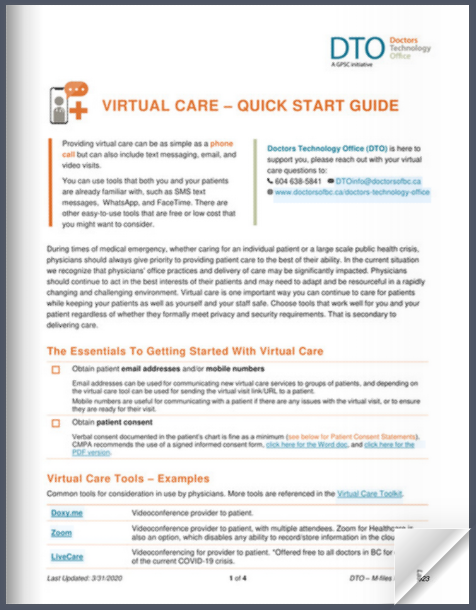 |
|
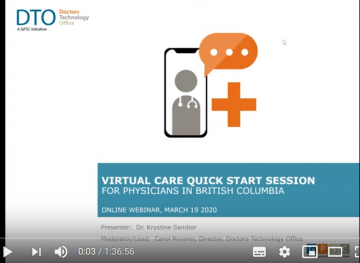 |
|
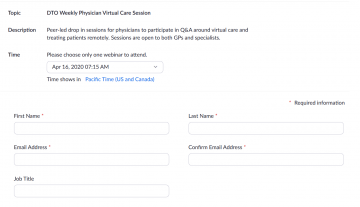 |
|
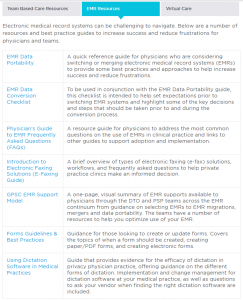 |
|
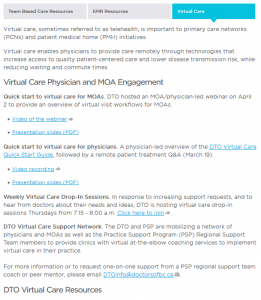 |
|
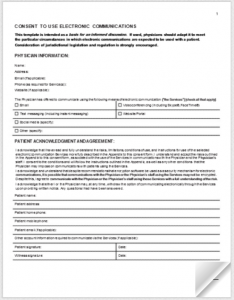 |
|
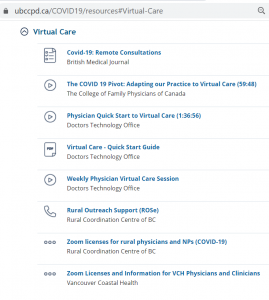 |
|
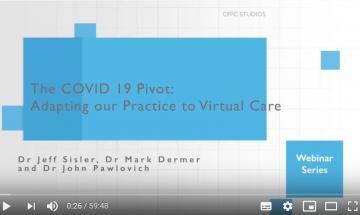 |
|
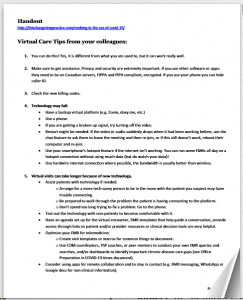 |
.
Virtual Care Platforms:
- Zoom licenses for rural physicians and NPs (COVID-19). Rural Coordination Centre of BC. https://rccbc.ca/zoom/. Updated April 8 2020. Accessed April 7, 2020.
- Intensivist support for rural providers managing COVID-19 and other viruses. Rural Coordination Centre of BC: Rural Outreach Support (ROSe). View on RCCbc website. Published March 17, 2020. Accessed April 7, 2020
- Online doctors, virtual health & prescriptions in Canada. Maple. https://www.getmaple.ca/. Published 2020. Accessed April 7, 2020.
- COVID-19 Virtual Health Toolkit. Provincials Health Services Authority. View on PHSA. Updated 2020. Accessed April 8, 2020.
- Digital Health Supports for COVID-19. eHealth. http://ehealthce.ca/COVID-19.htm. Updated 2020. Accessed April 8, 2020.
- WELL Health Virtual Clinic +WELL Health Technologies Corp. https://www.well.company/. Updated 2020. Accessed April 7, 2020.
Email Information:
- Email Template to Send to Patients. Doctors of BC. Download from bccfp.bc.ca. Published March 2020. Accessed April 7, 2020.
- Provincials Health Services Authority. View phsa.ca Virtual Health Toolkit: Email. Updated 2020. Accessed April 8, 2020.
eFaxing/Technology Support:
- Introduction to Electronic Faxing Solutions (E-Faxing Guide). Doctors Technology Office. View guide. Updated 2019. Accessed April 7, 2020.
- Telemedicine and virtual care guidelines (and other clinical resources for COVID-19). Royal College of Physicians and Surgeons of Canada. View Royal College guidelines. Updated March 20 2020. Accessed April 8, 2020.
Practice Support Program, General Practice Service Committee
- http://www.gpscbc.ca/what-we-do/practice-supports/psp. Updated 2020. Accessed April 7, 2020.
- http://gpscbc.ca/what-we-do/practice-supports/psp/coaching-and-mentoring. Updated 2020. Accessed April 7, 2020.
Physician Health Program – Personal Wellness:
- Physician Health Program (PHP): COVID-19 Physician Peer Support Sessions. Doctors of BC. Sign up for sessions. Updated 2020. Accessed April 7, 2020.
- Physician Health Program (PHP): 24/7 Confidential Helpline. Physician Health Program. View support services. Updated 2020. Accessed April 7, 2020.
Billing Information:
- Billing changes – COVID-19. Doctors of BC. View. Updated 2020. Accessed April 7, 2020.
- Billing for Virtual Care and Phone Calls. BC Family Doctors. View Billing for Virtual Care. Published March 16 2020. Accessed April 7, 2020.
- Billing in the time of COVID-19. BC Family Doctors. https://bcfamilydocs.ca/covid19/. Updated March 31 2020. Accessed April 7, 2020.
COVID-19 Resources:
- Covid-19. BC College of Family Physicians (BCCFP). https://bccfp.bc.ca/covid-19/. Updated 2020. Accessed April 8, 2020.
- Information on Novel Coronavirus. BC Centre for Disease Control. View. Updated April 7 2020. Accessed April 8, 2020.
- Covid-19. BC Centre for Disease Control. View. Updated 2020. Accessed April 8, 2020.
- Covid-19 Care. BC Centre for Disease Control. View. Updated 2020. Accessed April 8, 2020.
- COVID-19 Information and Resources. The College of Family Physicians of Canada (CFPC). View. Updated April 2 2020. Accessed April 8, 2020.
- UBC CPD COVID-19 Resource Hub. https://ubccpd.ca/COVID19 Updated April 12 2020. Accessed April 13, 2020.
CPSBC:
- College of Physicians and Surgeons of BC. Telemedicine Practice Standard Revised. View. Updated Apr 1,2020. Accessed Apr 14, 2020.
- College of Physicians and Surgeons of BC. Prescribing Medications During the COVID-19 Pandemic. View. Accessed Apr 14, 2020.
.

For homebound patients who are linked with home health (during COVID-19, and hopefully ongoing afterwards): it can be very helpful to do a virtual visit *during* the home care nursing visit. Nurses can help with many aspects of the virtual visit. Particularly helpful: they can perform a physical exam and report findings in real time.
Coordinate a visit by communicating with your local home health team. Scheduling will depend on nursing availability and capacity; home health is quite busy these days!
This is new practice / new technology for home health nurses also – but we are all learning fast.
As a physician whose sole practice is visiting homebound patients, I am excited for us as a healthcare system to make good use of this technology. “Visiting” patients at home really helps me understand their lives so much better (challenges I could not have imagined, creative ways patients manage medications at home, how our instructions are interpreted, realities of caregiving – the list is endless). Virtual visits are definitely different than in-person home visits, but so far I have been impressed with how well the technology works (I do notice “paid” products work better than free ones).
I hope increased, *appropriate* use of virtual-visiting technology now and in the future will enable us to provide better and more equitable care overall, especially for those who are homebound for all kinds of reasons.